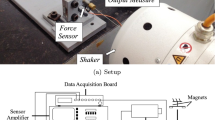Abstract
Volterra and Wiener theories provide the concepts of linear,bilinear, tri-linear, etc., kernels, which upon convolution with theexcitation force, can be employed to represent the response of anonlinear system. Based on these theories, higher-order frequencyresponse functions (FRFs) are employed to estimate the nonlinearstiffness of rolling element bearings, supporting a rigid rotor. Therotor-bearing assembly is idealized as a single-degree-freedom system,with cubic nonlinearity. The analysis involves a third-order kernelrepresentation of the system response. The first and third-order kerneltransforms are extracted from the measurements of the appliedwhite-noise excitation and the resultant response. A third-order kernelfactor is synthesized from this first-order kernel and is processedalong with the third-order kernel for estimation of the nonlinearparameter. Damping is assumed to be linear in the analysis. Theprocedure is demonstrated through measurements on a laboratory test rig.
Similar content being viewed by others
References
Volterra, V., Theory of Functionals and of Integral and Integro-Differential Equations, Dover, New York, 1958.
Billings, S. A., ‘Identification of nonlinear systems – A survey’, Proceedings of IEEE 127(6), 1980, 272–285.
Korenberg, M. J. and Hunter, I. W., ‘The identification of nonlinear biological systems: Wiener kernel approaches’, Annals of Biomedical Engineering 18, 1990, 629–654.
Rugh, W. J., Nonlinear System Theory: The Volterra/Wiener Approach, Johns Hopkins University Press, Baltimore, MD, 1981.
Wiener, N., Nonlinear Problems in Random Theory, The Massachusetts Institute of Technology and John Wiley and Sons, New York, 1958.
Lee, Y. W. and Schetzen, M., ‘Measurement of Wiener kernels of nonlinear system by crosscorrelation’, International Journal of Control 2(3), 1965, 237–254.
French, A. S. and Butz, E. G., ‘Measuring the Wiener kernels of a nonlinear system using the fast Fourier transform algorithm’, International Journal of Control 17(3), 1973, 529–539.
Crum, L., ‘Simultaneous reduction and expansion of multidimensional Laplace transform kernels’, in Proceedings of 1st Symposium on Test and Identification of Nonlinear Systems, 1975, pp. 89–105.
Bedrosian, E. and Rice, S., ‘Application of Volterra-system analysis’, in Proceedings of 1st Symposium on Test and Identification of Nonlinear Systems, 1975, pp. 15–27.
Orabi, I. I. and Ahmadi, G., ‘A functional series expansion method for response analysis of nonlinear systems subjected to random excitations’, International Journal of Non-Linear Mechanics 22(6), 1987, 451–465.
Gifford, S. J. and Tomlinson, G. R., ‘Recent advances in the application of functional series to nonlinear structures’, Journal of Sound and Vibration 135(2), 1989, 289–317.
Bendat, J. S., Nonlinear System Analysis and Identification from Random Data, Wiley, New York, 1990.
Bendat, J. S., Nonlinear System Techniques and Applications, Wiley, New York, 1998.
Khan, A. A. and Vyas, N. S., ‘Non-linear parameter estimation using Volterra and Wiener theories’, Journal of Sound and Vibration 221(5), 1999, 805–821.
Ragulskis, K. M., Jurkauskas, A. Yu., Atstupenas, V. V., Vitkute, A. Yu., and Kulvec, A. P., Vibration of Bearings, Mintis Publishers, Vilnius, 1974.
Harris, T. A., Rolling Bearing Analysis, Wiley, New York, 1984.
Dimentberg, M. F., Statistical Dynamics of Nonlinear and Time-Varying Systems, Research Studies Press/Wiley, New York, 1988.
Stolarski, T. A., Tribology in Machine Design, Heinemann Newnes, Oxford, 1990.
Choy, F. K., Braun, M. J., and Hu Y., ‘Nonlinear transient and frequency response analysis of a hydrodynamic journal bearing’, ASME Journal of Tribology 114, 1992, 448–454.
Childs, D., Turbomachinery Rotordynamics: Phenomena, Modeling and Analysis, Wiley-Interscience, New York, 1993.
Soong, T. T. and Grigoriu, M., Random Vibration of Mechanical and Structural Systems, Prentice-Hall, Englewood Cliffs, NJ, 1993.
Lin, Y. K. and Cai, G. Q., Probabilistic Structural Dynamics. Advanced Theory and Applications, McGraw-Hill, New York, 1995.
Zhou, R. S. and Hashimoto, F., ‘A new rolling contact surface and ‘no run-in’ performance bearings’, ASME Journal of Tribology 117, 1995, 166–170.
Schetzen, M., The Volterra and Wiener Theories of Nonlinear Systems, Wiley, New York, 1980.
Raemer, H. R., Statistical Communication Theory and Applications, Prentice-Hall, Englewood Cliffs, NJ, 1969.
Tiwari, R. and Vyas, N. S., ‘Estimation of nonlinear stiffness parameters of rolling element bearings from random response of rotor bearing systems’, Journal of Sound and Vibration 187(2), 1995, 229–239.
Author information
Authors and Affiliations
Rights and permissions
About this article
Cite this article
Khan, A.A., Vyas, N.S. Application of Volterra and Wiener Theories for Nonlinear Parameter Estimation in a Rotor-Bearing System. Nonlinear Dynamics 24, 285–304 (2001). https://doi.org/10.1023/A:1008352829782
Issue Date:
DOI: https://doi.org/10.1023/A:1008352829782




